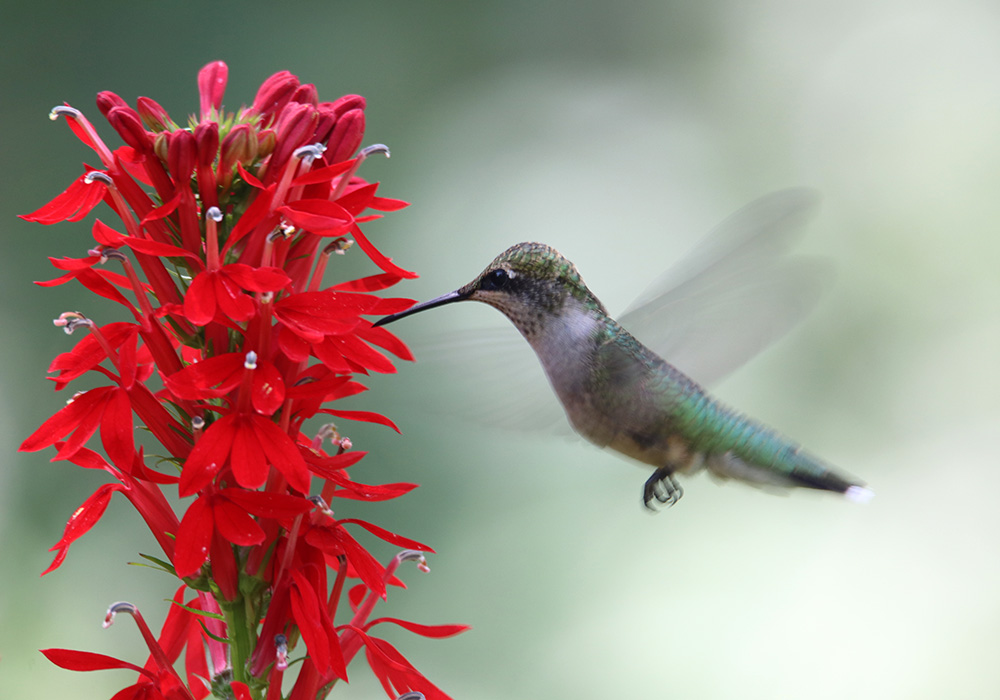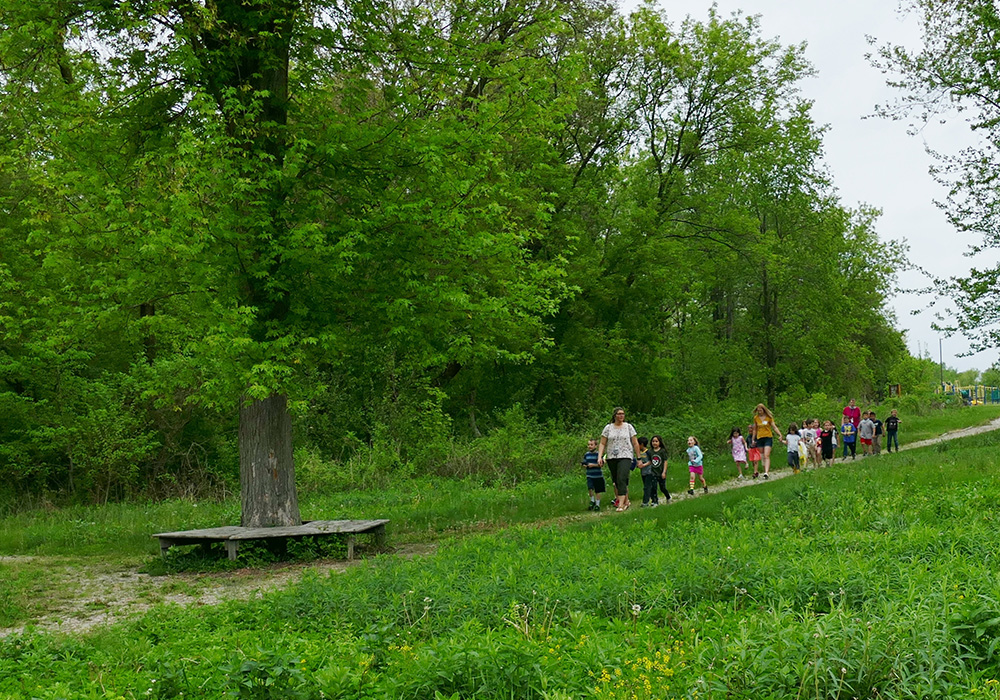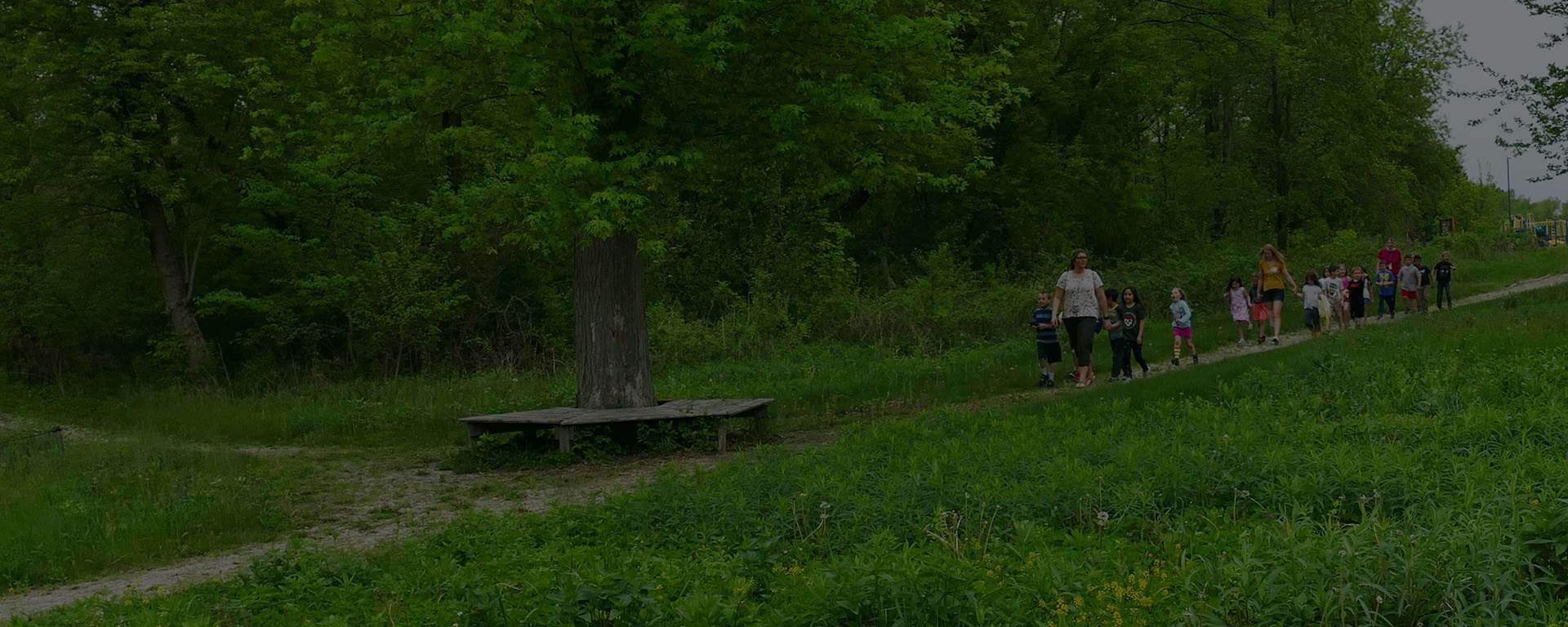
You are welcome to republish this story through the Creative Commons license CC BY-NC-SA 4.0. Where republishing conditions differ for images, this is noted in individual captions. (See this page for more information.)
By Laurie Lawlor
Laurie is the author of Restoring Prairie, Woods, and Pond: How a Small Trail Can Make a Big Difference (Holiday House, 2023).
This story was published on World Rewilding Day 2024. The latest instance of this annual celebration of rewilding projects carries the theme of #HopeIntoAction, something for which the below story is a perfect fit.
The eight-acre lot in the small, rural town of Eagle, Wisconsin, appeared anything but promising. Over the years, the dumping ground of rusty cans, bottles, and old tires had become so choked with buckthorn and other invasive plants that nobody knew what was inside the municipally owned property between the local elementary school and the public library. Students traveling on foot or bikes from school to the library had to go into the icy and sometimes busy street because there was no sidewalk.
Safety concerns prompted a discussion among a small group of residents in 2008. Why not cut a path through the lot? In this hardscrabble, southeastern Wisconsin community with few resources, everyone in Eagle understood that the work would have to be as low-cost as possible.
In the spring of 2010, the project’s mission changed dramatically when two volunteers, both native plant enthusiasts, bushwhacked through dense thickets to create a plant inventory. Despite decades of neglect, the land revealed unexpected prairie native treasures in the form of a few purple coneflowers. In addition, scattered woodland survivors—thimbleweed and black elderberry—provided clues of a once-healthy forest.
The biggest surprise, though? Frog song.
In the middle of the ravaged lot hid a patch of glittering water—an ephemeral pond. This special wetland, which is filled with snowmelt and rainwater, serves as an important home in spring for tadpoles, salamanders, and fairy shrimp.
Forensic research into the early history of the region revealed that this piece of land had been part of a large prairie. The ephemeral pond showed up on early maps. These discoveries inspired the inventory team to try to convince other volunteers to attempt something bigger and more ambitious. Why not create a path bisecting three ecosystems: native prairie, woodland, and pond? Planting native species would showcase what the land once was. Restored habitat would attract native insects, birds, and other animals.
The new rewilding plan required harnessing volunteer labor and inspiring donations of everything from prairie seeds to tractors and chainsaws. Dave Traver, a local resident and library board member, realized that the project’s success depended on reaching out to a broad group with different skills, who would all need to be willing to work together. Finding a common goal was the key in a town where opinions about politics and the environment vary widely.
Traver was convinced that you can’t inspire a diverse group of people by using a frontal attack about nature. “That’s not how opinions are changed,” he says. “There are people out there who are extremely decent. They may not be especially appreciative of nature stuff, but there’s something they can offer a community project like this.”
His strategy was to find out what an individual’s talent was, develop a relationship with that person based on a shared interest, and then ask if they’d like to help with trail building—whether it was running a backhoe or baking an upside-down pineapple cake to feed volunteers.
Eventually, a network of trail builders—from volunteer firefighters and retired teachers to local business owners and high school students—put aside their differences, rolled up their sleeves, and went to work. Some collected trash; others hauled away branches. Kids helped pull up invasive plants. Local people showed up with backhoes, stump-pullers, more tractors, shovels, and rakes. In the fall of 2010, the prairie area was cleared of brush and weeds; the ground was leveled. Volunteers laid out a path and spread crushed stone. Soon people of all ages from the neighborhood were stopping to watch the arrival of trucks and excavators. Could they help, too?
Home Depot donated materials, and a team of employee volunteers built a boardwalk, a small amphitheater, and a bench. A wholesale native plant nursery donated prairie seed mix. In the spring and summer of 2011, the prairie was planted by hand. The first of many native bur oak saplings were transplanted and watered.
With only a bare-bones budget, the dumping ground was transformed into the Eagle Nature Trail and outdoor classroom—a refuge for native plants, animals, and the whole community.

Despite setbacks of droughts and a flood that prompted pond frogs to surge around the library doorway, the project has remained true to its mission. And, among other accolades, the Eagle Nature Trail was awarded, in 2014, the Virginia M. Kline Award for Excellence in Community-Based Restoration, a program of the Aldo Leopold Foundation.
Dedicated teachers continue to find new ways to celebrate seasonal change, observation, and wonder with an outdoor curriculum dedicated to art, social studies, and science. Activities include writing Earth Day poetry, sketching growing plants, and looking at pond water under a microscope. Students participate in everything from prairie planting and weed pulls to milkweed pod tosses to spread more native plants for monarch butterflies.
During the Covid-19 pandemic, visiting the trail and helping with the work of stewardship has continued to be a helpful way to combat despair and anxiety for people of all ages. There’s a clear benefit to stepping away from computer, phone, and TV screens to explore the outdoors—and not just looking out of a car window at passing scenery. As former principal Matt Stich explains, “You see the difference it makes when kids go outside and experience the environment directly.”
The Eagle Nature Trail continues to encourage stewardship participation from individuals in the community, local colleges, high schools, and beyond. Rewilding has been a hopeful process that has changed a small part of the landscape while inspiring the next generation. The impact can be far-reaching. “We never know whose attitudes about the environment we’ve helped change,” says Jean Weedman, a long-time local organizer.

As biodiversity of native plants in the woodland, prairie, and pond has improved each year, so has the variety of native animals. Foxes, possums, groundhogs, rabbits, deer, woodpeckers, great horned owls, hawks, sandhill cranes, ducks, and geese have become frequently sighted visitors and residents. A growing population of great spangled fritillaries—butterflies of the prairie in summer—have their beginnings as caterpillars hatched among woodland violets. Meanwhile, the refuge has become an important stopover for migrating ruby-throated hummingbirds, scarlet tanagers, and indigo buntings, who make an amazing 600-mile trip across the Gulf of Mexico.
The journeys of these remarkable wild animals remind us how important even small places like the Eagle Nature Trail can be in helping protect nature locally and globally.

